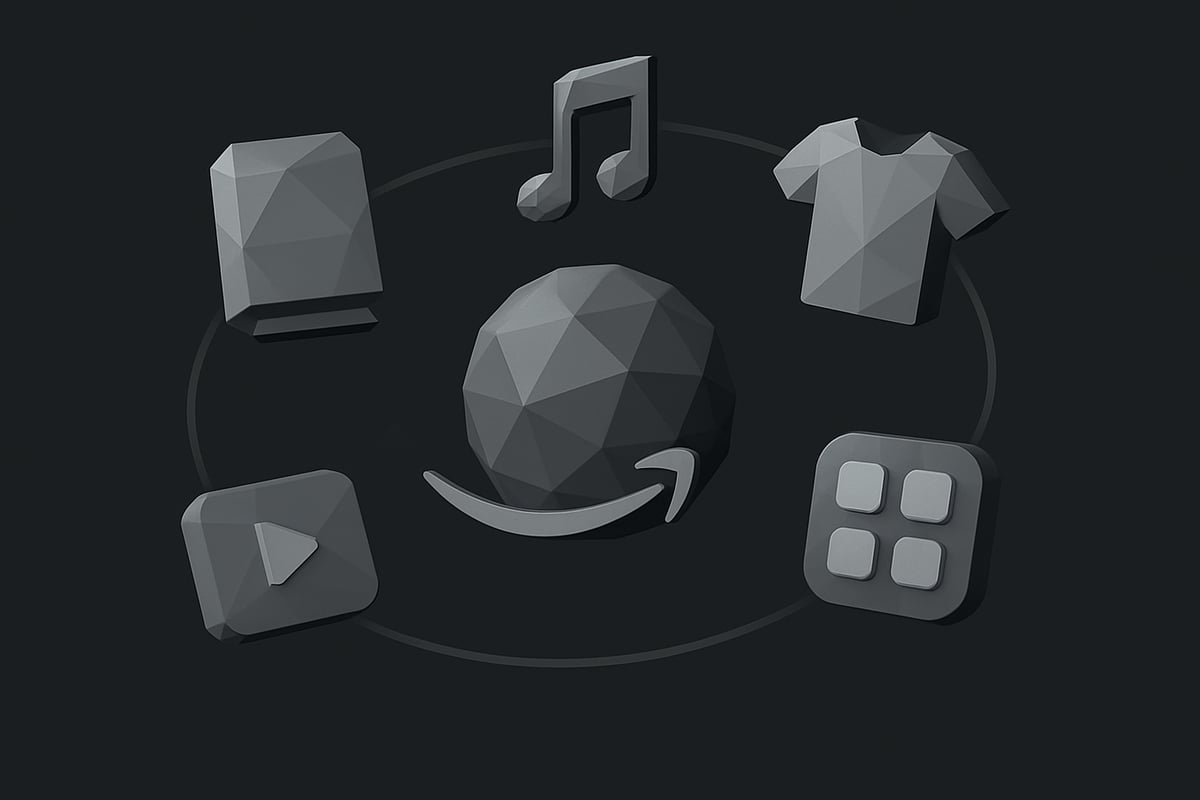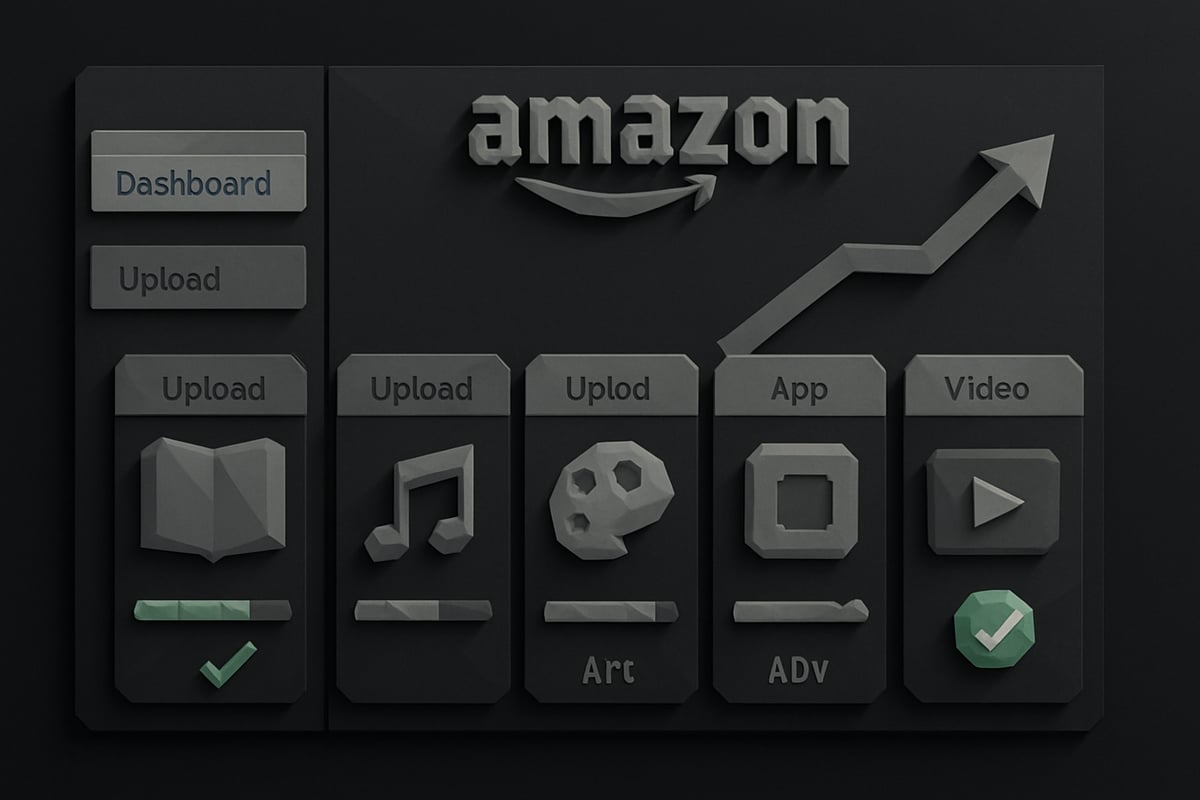Amazon’s digital product marketplace is booming, unlocking new opportunities for creators and entrepreneurs in 2025. Every day, more people are turning their passion into profit by tapping into the demand for amazon digital products.
This guide is your roadmap to confidently navigate, create, and sell successful digital products on Amazon. You’ll discover step-by-step how to leverage the latest trends and best practices, giving you an edge in this fast-growing space.
Ready to explore the types of amazon digital products, their key benefits, and the trends shaping 2025? Learn how to validate your ideas, launch your listings, and master strategies for passive income success. Dive in and start your journey to Amazon digital product success today.
Understanding Amazon Digital Products in 2025
Amazon digital products are any goods that customers can buy and access instantly on their devices, without needing anything shipped to their door. These include eBooks, music, digital art, mobile apps, audiobooks, and video content. Unlike physical or hybrid products, amazon digital products are delivered electronically and managed entirely online, making them uniquely scalable.
Amazon’s digital product ecosystem keeps expanding. Sellers can now launch Kindle eBooks, design apparel through Merch on Demand, distribute music via TuneCore, publish apps on the Amazon Appstore, self-publish audiobooks on Audible, and even share video content through Prime Video Direct. Between 2020 and 2022, KDP royalties alone grew by 40%, reflecting the surge in demand. For a deeper dive into the different types and examples, check out Types of Digital Products Explained.

Defining Digital Products on Amazon
Amazon digital products include:
- eBooks: Sold through Kindle Direct Publishing (KDP), from low-content journals to complex novels.
- Digital Art and Graphics: Offered on Merch on Demand as designs for apparel, mugs, and more.
- Music: Distributed via TuneCore to over 150 stores and streaming services.
- Apps and Games: Available on the Amazon Appstore, reaching 150 million+ devices.
- Audiobooks: Self-published on Audible for a global audience.
- Video: Shared using Prime Video Direct for filmmakers and educators.
These platforms let creators reach millions without physical inventory. Amazon digital products are different from traditional goods because they are delivered instantly and updated easily. The ecosystem is dynamic, with platforms like KDP, Merch, and TuneCore offering quick approvals and global reach.
Major Categories and Their Potential
Let’s compare the major categories and their potential in the amazon digital products space:
| Category | Platform(s) | Reach/Impact | Example Product |
|---|---|---|---|
| eBooks | KDP | Global, top-selling, low to high content | Language guides, fiction novels |
| Graphics/Art | Merch on Demand | Apparel, accessories, print-on-demand | T-shirt designs, mugs |
| Music | TuneCore | 150+ platforms, worldwide streaming | Singles, albums |
| Apps & Games | Amazon Appstore | 230+ countries, 150M+ devices | Puzzle games, productivity apps |
| Audiobooks | Audible | Global, subscription and a la carte | Self-help audiobooks |
| Video | Prime Video Direct | Streaming to Prime subscribers, educational content | Indie films, online courses |
eBooks continue to dominate, thanks to KDP’s massive reach and low entry barrier. Merch on Demand is a hotspot for artists and designers, while TuneCore’s distribution powers global music sales. The Appstore connects developers to millions of mobile users, and Audible provides a lucrative path for audio storytellers. Video content, especially microlearning and indie films, is gaining traction.
What’s New in 2025: Trends & Opportunities
The landscape for amazon digital products is rapidly evolving. Here are the top trends shaping 2025:
- AI-Generated Content: Tools now help creators produce eBooks, art, and music faster than ever.
- Interactive & Multimedia Demand: Buyers want more engaging, interactive products, from choose-your-own-adventure eBooks to gamified learning.
- Expanded Categories: Amazon keeps adding new formats, supporting more types of creators.
- Cross-Platform Bundling: Sellers can now package eBooks, audiobooks, and video together for increased value.
- Instant Access & Passive Income: The hunger for instant downloads continues to rise, with more creators earning passive income from automated sales.
Recent growth in AI-powered slideshows, faceless video, and microlearning modules shows how sellers are adapting. As the appetite for amazon digital products grows, those who embrace these shifts will find more ways to stand out and succeed.
The Benefits of Selling Digital Products on Amazon
Selling amazon digital products brings a unique set of advantages that make it one of the most accessible and scalable online business models. Whether you are a creator, entrepreneur, or side hustler, Amazon offers a powerful ecosystem that opens doors to global audiences and recurring income streams.

Low Barrier to Entry & Minimal Investment
One of the biggest draws of amazon digital products is how easy it is to get started. Unlike physical goods, there is no inventory to purchase, store, or ship. Everything happens online, so you avoid the headaches of logistics and fulfillment.
Amazon’s digital platforms, like KDP and Merch on Demand, have fast approval processes. For example, you can publish an eBook and have it live in under 72 hours. Musicians releasing tracks through TuneCore often see their music available within two business days.
Startup costs are extremely low. Your main investment is your creativity and time, not manufacturing or shipping fees. Compared to Amazon FBA or traditional retail, you can launch amazon digital products in days rather than months. Many creators publish their first products over a weekend, making this model approachable for beginners and seasoned pros alike.
High Profit Margins & Passive Income Potential
Amazon digital products offer some of the highest profit margins in ecommerce. Once created, your product can be sold an unlimited number of times with almost zero additional cost. This means each sale puts more profit in your pocket.
Royalties are a major perk. Platforms like KDP, Merch, and TuneCore pay out recurring revenue, so you earn money even while you sleep. Some KDP authors have reported earning over $50,000 in royalties, thanks in part to a 40% rise from 2020 to 2022. Want to see which products are performing best? Check out the Best Selling Digital Products on Amazon to spot trends and opportunities.
The passive income potential is real. Once your amazon digital products are approved and listed, you can focus on scaling and creating new offerings. There’s no cap on how many products you can list, making long-term growth achievable.
Global Reach & Amazon’s Built-In Audience
When you sell amazon digital products, you tap into Amazon’s massive, worldwide customer base. Millions of shoppers trust Amazon’s platform, and your products become instantly accessible to this audience.
Amazon handles the heavy lifting. All payments, downloads, and customer service processes are managed for you. Buyers get instant access to their purchases, whether it’s an eBook, song, or digital artwork.
This global reach is a game-changer. For example, music distributed via TuneCore can appear on platforms like Spotify and Apple Music in over 150 countries. Your digital products can generate sales 24/7, reaching customers in every time zone, all without extra effort on your part.
Easy Management, Automation, and Scalability
Managing amazon digital products is remarkably simple thanks to Amazon’s automated systems. Once your product is listed, Amazon takes care of delivery and fulfillment. You don’t need to handle orders manually, freeing up your time to focus on creation and marketing.
Scaling is straightforward. You can add new products or variations without increasing complexity. Amazon provides built-in analytics, royalty reports, and product management tools to help you track performance and make data-driven decisions.
Many artists and entrepreneurs use Merch on Demand to automate apparel sales. With each new design, the process remains hands-off, letting you grow your portfolio of amazon digital products efficiently. This level of automation means you can build a sustainable, scalable business with ease.
Step-by-Step Guide: Creating and Validating Digital Products for Amazon
Ready to launch your journey with amazon digital products? Here, we break down the essential steps for anyone aiming to build, validate, and profit from digital creations on Amazon. Whether you are a writer, artist, musician, or developer, these steps will help you avoid common pitfalls while maximizing your potential for success.

Step 1: Identifying Profitable Niches and Product Ideas
Finding your niche is the foundation of successful amazon digital products. Start by researching Amazon’s marketplace for trending digital items—look for eBooks, art, music, or apps that consistently rank high in sales. Use sales and keyword tools like Jungle Scout Chrome Extension to uncover what’s hot.
Explore customer reviews to spot common complaints or unmet needs. Sometimes, a simple improvement can carve your space in a crowded market. Compare evergreen topics, which stay relevant year-round, with trending categories like AI-generated content or microlearning.
Don’t forget to validate your ideas with external data. Use Google Trends and competitor research to check sustained demand. For an in-depth dive into high-potential categories, check out Digital Product Niches for Amazon, which explores what’s working right now.
Success stories often come from creators who spotted gaps in low-content KDP books or leveraged AI art trends. Take notes, and you might find your breakout idea in the world of amazon digital products.
Step 2: Validating Demand Before Creation
Once you have a shortlist, it’s crucial to validate which amazon digital products are actually in demand. Search Amazon for competing products and check their Best Sellers Rank. High sales ranks can signal strong demand, but lots of competition means you’ll need a unique angle.
Dive into reviews—both positive and negative—to see what buyers love and what frustrates them. Evaluate keyword search volume using tools like Helium 10 or Google Keyword Planner. Look for seasonality, too—some topics spike at certain times of year.
Test your idea with a minimum viable product (MVP). Share a sample chapter, preview, or demo with a small audience. Gather feedback before investing more time and resources. This step ensures you are not creating amazon digital products no one wants.
Iterate based on real user input. Early feedback helps you refine your product and increase your odds of a successful launch.
Step 3: Defining Your Unique Value Proposition
Standing out is key in the competitive landscape of amazon digital products. Pinpoint what makes your offering different. Is it superior quality, unique features, or a novel format? Address a specific pain point or desire within your target audience.
Tailor your product to Amazon’s buyer demographics. For instance, bundle your eBook with an audiobook version, or offer interactive elements in your digital art. Unique art styles, educational extras, or exclusive content can set you apart.
Ask yourself: Why should someone choose your product over the rest? Make your value clear in every aspect—title, description, and even your cover design. In the amazon digital products arena, clarity and relevance drive conversions.
Step 4: Creating High-Quality Digital Products
Now it’s time to bring your amazon digital products to life. Use creation tools that fit your product type—Canva and Book Bolt for eBooks, professional audio software for music or audiobooks, and app development kits for software.
Follow best practices for formatting and quality. For eBooks, ensure clean layouts and error-free text. For music and audiobooks, prioritize crisp audio and proper metadata. Check Amazon’s content and quality guidelines to avoid rejections.
Professional design and usability matter. Invest in editing, proofreading, and beta testing. Many creators use AI tools to streamline content creation or enhance visuals. The goal is to deliver polished amazon digital products that delight customers and meet Amazon’s standards.
Step 5: Pricing Strategies for Digital Products
Pricing shapes the perception and success of your amazon digital products. Research similar products to find the sweet spot—too high, and you risk losing buyers; too low, and you may leave money on the table.
Understand Amazon’s royalty structures. For example, KDP offers 70% and 35% royalty options based on price and region. Test different price points to find what maximizes both sales and profit.
Consider offering bundles, discounts, or limited-time promotions to entice buyers. For instance, combine an eBook and audiobook for higher value. Experiment with pricing and track results—data-driven decisions are key to scaling your amazon digital products business.
How to List, Launch, and Optimize Your Digital Products on Amazon
Ready to see your amazon digital products live on the world’s largest online marketplace? Listing, launching, and optimizing your digital creations on Amazon is a game changer for any creator or entrepreneur. Let’s break down the essential steps so you can move from concept to customer with confidence.

Setting Up Seller Accounts for Each Platform
Launching amazon digital products starts with the right accounts. Each Amazon platform—KDP, Merch on Demand, TuneCore, Appstore, Audible, and Prime Video Direct—requires its own setup, but the process is straightforward.
Here’s a quick comparison:
| Platform | Product Type | Key Setup Steps |
|---|---|---|
| KDP | eBooks | Amazon login, tax info, bank |
| Merch on Demand | Apparel/Art | Invite, tax, design upload |
| TuneCore | Music | Register, verify, payment |
| Appstore | Apps/Games | Developer account, app files |
| Audible | Audiobooks | ACX profile, rights, payment |
| Prime Video Direct | Video | Amazon login, content, bank |
Be sure to have your tax details and banking information ready. Verification usually takes a few days. Navigating amazon digital products dashboards is intuitive, but double check all requirements before submitting.
For a detailed walkthrough, check out the Steps to Sell Digital Products for a platform-specific setup guide.
Uploading and Formatting Your Digital Products
Uploading amazon digital products requires attention to detail. Each platform has unique technical and content guidelines you must follow for approval.
Here are the essentials:
- KDP (eBooks): Format as .docx, EPUB, or PDF. Use tools like Book Bolt for interiors and covers.
- Merch on Demand: Upload PNG images at 300 DPI, correct size for apparel or accessories.
- TuneCore (Music): WAV files, album art 3000x3000px, metadata tags.
- Appstore: APK or app bundle files, screenshots, descriptions.
- Audible: High-quality MP3, cover art, chapter markers.
- Prime Video Direct: MP4 or MOV, closed captions, artwork.
Templates help reduce errors. Always preview your amazon digital products before submitting. Meeting Amazon’s formatting rules can mean faster approvals and fewer rejections.
Crafting Compelling Listings and Product Pages
Your product page is your storefront. A well-crafted listing for amazon digital products makes all the difference in discoverability and sales.
Focus on these elements:
- Title: Clear, keyword-rich, and concise.
- Description: Persuasive, benefits-focused, and easy to scan.
- Images/Previews: High resolution, accurate, and engaging.
- Bullets: Highlight key features, use formatting for clarity.
- SEO: Research and include relevant keywords naturally.
A+ Content (where available) lets you add rich visuals and comparison tables. According to Amazon Statistics: Key Data Every Seller Needs in 2025, optimized listings can significantly boost visibility and conversion rates for digital products.
Understanding Royalties, Payments, and Amazon’s Review Process
Each amazon digital products platform has its own royalty structure and payment timeline. For example, KDP offers 35% or 70% royalties depending on price and region, while Merch on Demand pays per item sold. TuneCore and Audible have their own payout systems.
Payments are typically monthly, with minimum thresholds. After uploading, your product goes through a review process—KDP usually takes up to 72 hours, TuneCore about 2 business days. If something is rejected, Amazon will specify the required changes.
Stay organized by tracking your submissions and payments within each dashboard. Understanding these processes ensures you’re never caught off guard.
Launching and Promoting Your Digital Products
Once your amazon digital products are live, it’s time to drive traffic and sales. Start with Amazon Advertising—PPC and Sponsored Products can quickly boost visibility. Early reviews and sales help build momentum.
Promote externally through social media, email lists, and influencer partnerships. Consider cross-promoting multiple product types, like bundling an eBook with its audiobook version.
Run launch campaigns with limited-time discounts or bonuses to encourage initial purchases. Monitor your performance and adjust strategies based on what works best for your audience.
Advanced Strategies for Scaling Digital Product Success on Amazon
The landscape of amazon digital products is evolving at lightning speed. To stand out and maximize your sales potential, you need to go beyond the basics. Advanced strategies can help you analyze data, build a loyal audience, expand your product lines, automate your business, and stay ahead of shifting policies and competition. Let’s break down the proven methods that top sellers use to scale their amazon digital products in 2025.
Leveraging Data and Analytics for Growth
Understanding your numbers is essential for scaling amazon digital products. Amazon offers robust analytics for each digital platform, allowing you to track sales, conversion rates, and customer engagement. Use this data to identify winning products, optimize underperformers, and spot new opportunities.
Here’s a quick comparison table of key metrics to monitor:
| Metric | Why It Matters |
|---|---|
| Sales Volume | Measure of product demand |
| Conversion Rate | Effectiveness of listings |
| Review Ratings | Quality and customer satisfaction |
| Traffic Sources | Where buyers are coming from |
Leverage split testing for covers, descriptions, and pricing. Monitor competitor activity using tools and keep an eye on overall market trends. According to Amazon Marketplace Seller Statistics 2025, the digital product space is more competitive than ever, so data-driven decisions are your key advantage.
Building a Brand and Audience Beyond Amazon
Building a recognizable brand is a game changer for amazon digital products. Start by creating a consistent author page, artist profile, or developer identity on Amazon. This gives your customers a face to trust and a reason to return.
Collect emails from your buyers to build a direct communication channel for launches and promotions. Drive traffic to your amazon digital products from blogs, YouTube, podcasts, and social media platforms. Authority in your niche comes from delivering value and engaging with your audience.
Did you know there are now over 9.7 million sellers on Amazon? This statistic from Amazon Statistics: 9.7M Sellers & Key Data 2025 highlights why brand loyalty is so important. A strong brand presence will help you rise above the noise.
Expanding Product Lines and Bundling Offers
Scaling up your amazon digital products often means expanding your catalog. Look for opportunities to create complementary offerings, such as pairing an eBook with a workbook, or releasing your music alongside branded merchandise.
Bundling is a powerful strategy to increase perceived value and boost your average order size. Consider launching your content in multiple formats, like audiobooks and video, to reach more customers.
Experiment with cross-promotions between your own products. For example, if you have a successful KDP eBook, bundle it with an exclusive audiobook or a downloadable worksheet. The more options you offer, the more you can grow your digital product empire.
Automation and Passive Income Optimization
One of the biggest advantages of amazon digital products is the ability to automate many aspects of your business. Set up systems for automated sales, fulfillment, and customer support using Amazon’s built-in tools.
Recurring promotions and automated email sequences can keep your products in front of buyers without daily manual effort. Consider outsourcing parts of your workflow, such as content creation or social media management, to free up your time.
Automation lets you scale your catalog without increasing your workload. As your portfolio grows, optimizing these systems is key to maintaining and increasing your passive income from amazon digital products.
Staying Ahead: Adapting to Amazon’s Policies and Market Shifts
Amazon frequently updates its policies and features for digital sellers. To succeed with amazon digital products, you need to stay informed and adaptable. Monitor Amazon’s announcements and adjust your strategies as needed.
Stay on top of emerging formats, such as AI-generated content or new multimedia options. Pivot quickly to capitalize on these trends. With the digital marketplace projected to reach new heights, sellers who react fast to changes often capture the biggest rewards.
Leverage market data and community forums to learn about upcoming shifts. Remember, the competitive landscape is always evolving. By keeping your finger on the pulse, your amazon digital products can remain relevant and compliant, even as the market changes.
Overcoming Common Challenges and Pitfalls
Scaling amazon digital products comes with its share of obstacles. Here are some common challenges and how to navigate them:
- Account suspensions or content rejections: Always follow Amazon’s guidelines and respond quickly to issues.
- Negative reviews or customer complaints: Address feedback professionally and use it to improve your offerings.
- Oversaturated niches: Focus on unique value and quality to stand out.
- Copyright and intellectual property: Protect your work and respect others’ rights.
Every setback is a learning opportunity. The most successful sellers are those who iterate, adapt, and never stop improving their amazon digital products.
We’ve covered a lot about building and launching digital products on Amazon, from identifying hot trends to automating your income streams. If you’re feeling inspired but aren’t sure where to start, you’re not alone—finding the right product idea can make all the difference. That’s why I recommend checking out a curated collection of real digital product ideas, complete with market data and guidance to help you take action with confidence. It’s the perfect next step if you want to turn your knowledge into a thriving Amazon business. Ready to see what’s possible? View Product Ideas